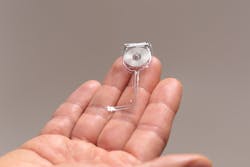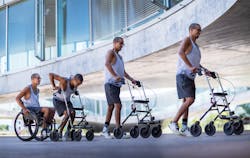First Bioresorbable Medical Device Will Provide Treatment Inside the Body
Electrical stimulation is a powerful tool in medical surgery and rehabilitation. It can provide doctors with the ability to block a patient’s pain or help a disabled person the ability to walk again. Recently, David Mzee participated in a study at the École Polytechnique Fédérale de Lausanne (EPFL), a research institute and university in Lausanne, Switzerland, to help regain control of his paralyzed left leg. He was outfitted with an epidural electrical stimulation (EES) to help walk. The EES is a device implanted in the patient’s spinal cord; in Mzee’s case, it sent electrical signals to help him extend his knee, flex his hip, and even move his toes.
The problem with EES devices is that they are large pieces of external plastic and difficult to implant. Researchers at Northwestern University and Washington University School of Medicine in St. Louis have developed the first example of a bioresorbable electronic medicine. They have developed a prototype device that is an implantable and biodegradable wireless device that speeds nerve regeneration and improves the healing of a damaged nerve.
Traditional electric stimulation devices like the once used to help David Mzee walk are installed outside of the body. These devices can help stimulate spinal cord movement or block pain. The new device from Northwestern is a biodegradable which will help eliminate external hardware.
The small bioelectric device delivers a regular pulse of electricity to damaged peripheral nerves after a surgical operation. Materials scientists and engineers at Northwestern, along with neurosurgeons from Washington University, tested the device on rats to study its potential benefits.
The electrical pulses helped to accelerate the regrowth of nerves in the rats’ legs and enhanced the ultimate recovery of muscle strength and control. The device itself is the size of a dime and as thick as of sheet of paper. The device can operate within the body for two weeks before being naturally absorbed into the body. The thin flexible device wraps around an injured nerve and delivers electrical pulses at selected time points until it starts degrading in the body. The device is powered and controlled wirelessly by a transmitter outside the body, much like wireless charging a smartphone.
Within the study, the researchers studied how rats reacted to the device. The device provided one hour per day of electrical stimulation for three to six days. Over the next 10 weeks, they found that electrical stimulation helped muscle mass recovery and muscle strength when compared to a controlled rate receiving no electrical stimulation. The rat with the device had no adverse reaction to the device, nor when reabsorption was complete.
The researchers believe that this technology can one day replace or complement pharmaceutical treatment. “These engineered systems provide active, therapeutic function in a programmable, dosed format and then naturally disappear into the body, without a trace,” said Northwestern’s John A. Rogers, a pioneer in biointegrated technologies and a co-senior author of the study. “This approach to therapy allows one to think about options that go beyond drugs and chemistry.”
The device can be attached to damaged nerves and help stimulate muscle recovery and growth.
The device has been eight years in the making. Rogers and his lab have developed various electronic materials, design layouts, and manufacturing techniques to have a broad range of options for different potential treatments. The potential of biodegradable electrical devices is endless, with accelerated wound healing being one of many options. The study shows that the device can work as a temporary pacemaker or as an interface to the spinal cord and other stimulation sites in the body.



